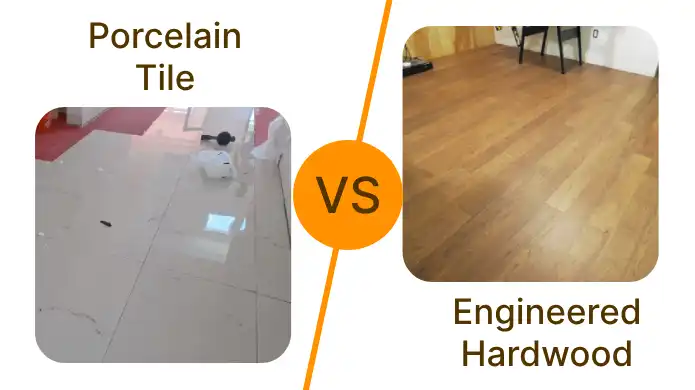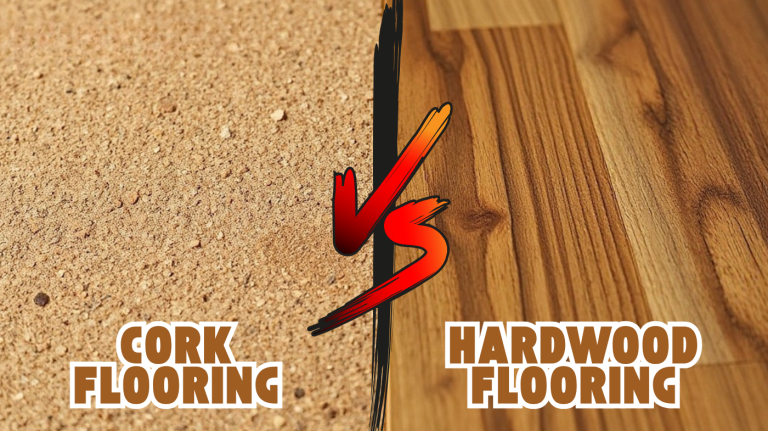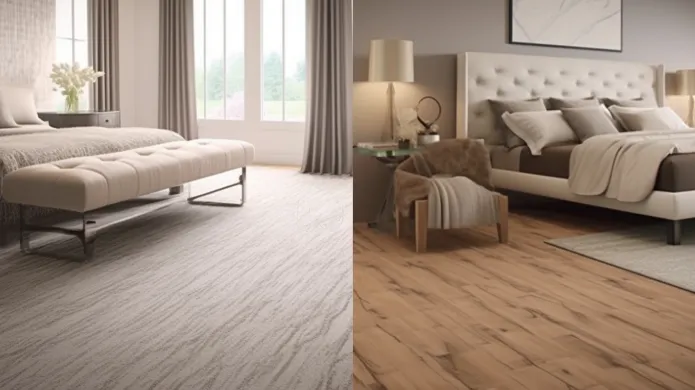Porcelain Tile vs Engineered Hardwood: A Detailed Comparison
One of the biggest decisions you’ll have to make when renovating your house is choosing the right flooring. Two popular options are porcelain tile and engineered hardwood.
In deciding whether to use porcelain tile or engineered hardwood, you should take into consideration your needs and preferences. That’s why you need to know the differences.
One of the primary distinctions lies in their material composition. Porcelain tiles are crafted using specific clay, sand, and feldspar kiln-fired at high temperatures to create a durable and less porous surface.
On the other hand, engineered hardwood comprises layers of hardwood veneer glued together, with a real wood top layer and layers of plywood or high-density fiberboard (HDF) underneath. Other differences exist between the two as well.
We’ll compare porcelain tile and engineered hardwood in more detail to help you decide on your home.
Porcelain Tile vs. Engineered Hardwood: What’s the Difference?
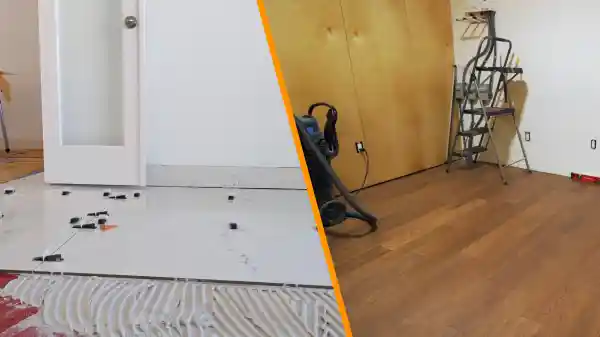
If you’re deciding between porcelain tile and engineered hardwood for your flooring needs, there are several factors to consider. These are the categories they differ in:
1. Material Composition
2. Durability and Maintenance
3. Water Resistance
4. Installation and Versatility
5. Cost Considerations
6. Comfort and Aesthetics
Let’s look at the differences in detail.
1. Material Composition
Porcelain tiles are produced by using specific clay and finely-ground sand, while engineered hardwood is composed of multiple layers of hardwood veneer.
The material composition of these two flooring options greatly differs, and it’s important to understand the key components that make up each.
Here are some key points to keep in mind when it comes to the material composition of porcelain tiles and engineered hardwood:
- Porcelain tiles are made using kaolin and ball clay, which are specific types of clay that are known for their strength and durability.
Finely-ground sand and feldspar are added to the mixture to create a less porous surface. This results in a product that is not only strong but also resistant to scratches, stains, and water damage.
- Engineered hardwood comprises multiple layers of hardwood veneer, with the top layer being made of real hardwood.
The bottom layers typically comprise plywood or high-density fiberboard (HDF). This construction creates a product that looks and feels like real hardwood, but is more affordable and more resistant to warping and shrinking.
2. Durability and Maintenance
When choosing between porcelain tile and engineered hardwood, durability and maintenance are two important factors to consider.
Porcelain tiles are known for their exceptional durability and resistance to scratches, scrapes, and wear. They are easy to clean and maintain, making them a practical choice for high-traffic areas.
However, porcelain tiles can occasionally chip, particularly around the edges, although this may not be noticeable with through-body composition.
On the other hand, engineered hardwood is also durable and can withstand regular foot traffic. However, it is more susceptible to scratches and dents compared to porcelain tile.
The top layer of real wood can be sanded and refinished a limited number of times, depending on its thickness. This allows for minor repairs and restoration over the lifespan of the floor.
Regular maintenance is required for both types of flooring to preserve their durability and appearance. For porcelain tiles, regular cleaning with a mild detergent and water is recommended.
For engineered hardwood, avoiding excessive moisture and using a cleaner specifically designed for hardwood floors is important.
3. Water Resistance
You’re looking for a flooring option to handle water spills and high humidity without warping or damaging. In this case, porcelain tiles are a great choice. They are highly water-resistant and can handle moisture without any adverse effects.
With porcelain tiles, you can be sure that your flooring will remain intact even in areas prone to water spills and high humidity, such as the bathroom and kitchen.
On the other hand, engineered hardwood, while more resistant to moisture compared to solid hardwood, is still susceptible to water damage. It can swell, warp or even develop mold and mildew with excessive exposure to water.
That’s why it’s not recommended for areas with high moisture levels, such as bathrooms or basements, unless proper precautions are taken, such as using moisture barriers or sealants.
If you want a flooring option that can handle moisture without any issues, porcelain tiles are the way to go.
4. Installation and Versatility
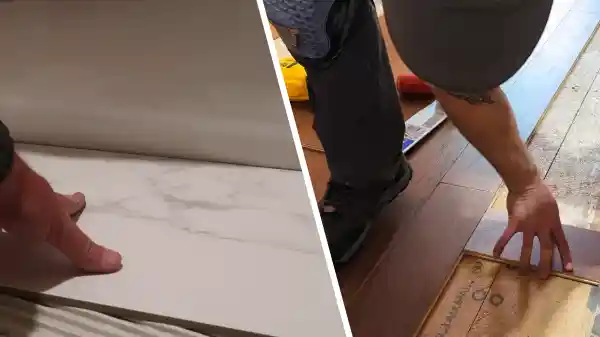
If you want to have a stress-free installation experience and the flexibility to install your flooring on various subfloors, then engineered hardwood may be the perfect choice for you.
Unlike porcelain tile, engineered hardwood can be installed using different methods depending on the specific product and subfloor. You can either glue, nail, or float the planks, making it easier to replace or remove them when necessary.
5. Cost Considerations
Now that you have a clearer understanding of the installation and versatility of porcelain tile and engineered hardwood, it’s time to talk about cost considerations.
While porcelain tile is generally more affordable than high-end hardwood flooring options, it’s important to remember that the cost of installation and additional materials should also be factored into your budget.
Depending on the complexity of your installation pattern or design, you may incur additional labor costs.
On the other hand, engineered hardwood can vary in price depending on the materials’ quality and the specific brand. It usually falls within a moderate to higher price range compared to porcelain tile.
Additionally, the installation cost for engineered hardwood may also vary depending on factors such as the complexity of the project, the need for subfloor preparation, and whether the professional installation is required.
6. Comfort and Aesthetics
Looking for a flooring option that not only looks great but also feels comfortable underfoot? Consider hardwood’s warmth and natural beauty, which can add a cozy and inviting atmosphere to your space.
Engineered hardwood provides a level of cushioning and insulation against cold temperatures, making it a more comfortable surface to walk on compared to porcelain tile. Its natural wood grain and variety of species, stains, and finishes available add character and sophistication to any room.
However, porcelain tile offers various design options, including different colors, patterns, and sizes. Wood-look porcelain tiles provide the look of hardwood with the durability and water resistance of tile.
While it can be paired with radiant floor heating systems to provide warmth, it may still feel colder during winter months compared to engineered hardwood.
Quick Comparison Chart of the Porcelain Tile vs Engineered Hardwood
| Criteria | Porcelain Tile | Engineered Hardwood |
| Material Composition | Made of clay, sand, feldspar, and kiln-fired | Multiple layers of hardwood veneer and plywood/HDF |
| Durability and Maintenance | Highly durable, scratch-resistant, easy to clean | Durable, but more susceptible to scratches and dents |
| Water Resistance | Highly water-resistant, suitable for wet areas | Resistant to moisture but can still be damaged by water |
| Installation and Versatility | Requires professional installation, various surfaces | Can be installed on different surfaces, multiple methods |
| Cost Considerations | Generally more affordable, installation costs should be considered | Moderate to higher price range, installation costs vary |
| Comfort and Aesthetics | Cool and hard surface, wide range of designs available | Warmer and more comfortable, natural beauty of real wood |
Can you use porcelain tile outdoors?
Porcelain tile is a viable option for outdoor use due to its durability and resistance to weather conditions.
Unlike other types of tile, porcelain tiles are designed to withstand harsh weather conditions such as rain, snow, and temperature fluctuations.
The low water absorption rate of porcelain tiles prevents moisture from seeping in, reducing the risk of cracking or damage during freeze-thaw cycles. This makes porcelain tiles an excellent choice for outdoor applications such as patios, balconies, and outdoor walkways.
Aside from its resistance to weather conditions, porcelain tile is also known for its strength and durability.
Porcelain tiles are made from high-quality materials that are fired at high temperatures, making them incredibly strong and long-lasting. This means they can withstand heavy foot traffic, outdoor furniture, and other elements of outdoor living.
Furthermore, porcelain tiles are available in a wide range of colors, patterns, and textures, allowing you to create a beautiful and long-lasting outdoor space that can withstand the demands of the environment.
At what temperature does porcelain tile crack?

Exposure to temperatures above 1600C compromises the durability of porcelain, leading to cracking or melting. This is why it’s crucial to avoid direct heat exposure to porcelain tiles, such as in the case of fireplaces.
However, other factors can contribute to the cracking of porcelain tiles, such as improper installation or movement of the subfloor. It’s important to hire a professional installer knowledgeable in properly installing porcelain tiles to avoid these issues.
In addition to avoiding direct heat exposure and ensuring proper installation, there are other ways to prevent porcelain tiles from cracking.
One way is to choose a thicker tile, as thicker tiles are less likely to crack than thinner ones. Opting for tiles with lower water absorption rates and higher breaking strengths can also increase the durability and resistance of porcelain tiles.
Does temperature affect engineered hardwood floors?
Temperature does affect engineered hardwood floors. Colder weather causes the wood to contract, resulting in the floorboards shrinking.
In addition, the drop in humidity due to running your heat causes the wood to dry out, further contributing to the shrinking.
This is why it is important to maintain a consistent indoor temperature and humidity level to ensure the longevity and durability of your engineered hardwood floors.
By doing so, you can prevent the boards from cupping and buckling and prolong the life of your beautiful floors.
The Beauty of Porcelain Tile vs. Engineered Hardwood: Choose the Perfect Fit for Your Home
Both porcelain tile and engineered hardwood have their unique advantages and considerations. Porcelain tile offers exceptional durability, water resistance, and a wide range of design options, making it suitable for high-moisture areas and outdoor applications.
On the other hand, engineered hardwood provides warmth, comfort, and the timeless beauty of real wood. It is more susceptible to scratches and water damage but can be sanded and refinished to restore its appearance.
When deciding between porcelain tile and engineered hardwood, it’s essential to consider the specific location, desired aesthetic, budget, and maintenance preferences.
Porcelain tile is a practical choice for areas prone to moisture, while engineered hardwood adds a touch of elegance and coziness to interior spaces.
Ultimately, the choice between porcelain tile and engineered hardwood will depend on your personal preferences and the specific requirements of your project.
Both options have their merits and can enhance the beauty and functionality of your home.

